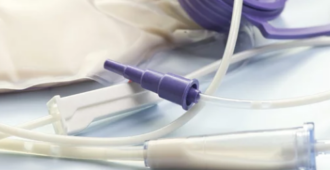Weight loss is a problem for many people living with MND, with approximately 20% of people already having lost 10% of their weight at diagnosis. Some of this weight loss may be due to a person experiencing difficulties with chewing and swallowing because of increased muscle weakness. It could be due to a lack of appetite because of tiredness, anxiety or low mood. It can also be caused by hypermetabolism which is when the body uses more energy than is being consumed, even without exercise, and is seen in some people with MND. Studies have shown that weight loss is linked to shorter survival.
At the 34th International Symposium on ALS/MND in Basel, Switzerland one of the sessions looked at nutritional assessment and management, with talks covering feeding tube management, the decision-making process of feeding tube placement, how diet might help slow progression, alternative ways to measure nutritional state and how appetite is controlled in the brain. In this series of five blogs, we are going to look a little closer at each of these studies and their potential for helping people living with MND. This is blog two in the series.
Feeding tubes: barriers in decision making for patients with ALS
In her talk, Kay Tran from the University of Utah discussed the barriers, or concerns, people living with MND face when making the decision about having a feeding tube fitted. This research was undertaken because there was very little literature regarding this available.
Impaired nutritional status, low BMI and unintentional weight loss are common occurrences in people living with MND. She suggested that this is often viewed positively in people who have had a lifetime of diet restrictions and problems related to being overweight such as diabetes, high blood pressure and high cholesterol. They can find it hard to understand that, in MND, weight management is important and weight loss is associated with poorer outcomes.
Previous studies have looked at quality of life, the desirability of extending life and the acceptance of the disease and its progression and found that these are factors that influence the decision. However, the decision is always a challenge for the individual and their caregivers and people living with the disease have said that ‘it feels like admitting defeat’. The purpose of Dr Tran’s study was to investigate the barriers to receiving a feeding tube to better understand the factors influencing whether to go forward or delay.
In individuals who consented to have a feeding tube fitted on the recommendation of their healthcare team, the researchers sought to assess the perceived benefits and satisfaction obtained from their decision through a questionnaire.
What did they find?
Before placement of the feeding tube, 38% of respondents did not want to extend their life with gastrostomy, 32% were fearful of the procedure and 34% were concerned that a feeding tube would limit their usual activities. Other concerns were changes in body image, impact on quality of life, difficulties in using the tube, limited ability to eat and drink normally, extra expenses (if not covered by US medical insurance) and risk of pain and infection.
Other factors influencing the decision were stress and anxiety for both people with MND and their caregivers, and the risk of choking.
The researchers found it interesting that their data indicated that the largest barrier was the prospect of extending life as the treatments that are available in the USA are believed to slow progression and people with MND welcome those.
After placement, a second questionnaire asked:
- If individuals were satisfied with the procedure?
- If they would do it again?
- Would they recommend it to others?
Eighty nine percent of individuals who received a feeding tube were satisfied with their decision, with similarly high numbers confirming they would do it again and would recommend the procedure to others.
The benefits, which were to be monitored, were perceived as:
- Changes to energy levels.
- Weight maintenance.
- Change to duration of meals.
- Changes to quality of life.
- Changes to stress levels.
Almost half of respondents reported that they were better able to manage their weight, and just over half expressed a reduction in stress levels for both them and their caregivers.
The questionnaire also included additional questions regarding:
- Terminology – could other words or phrases be used that would be more appreciated?
- Common misconceptions.
- Food and fluid intake before and after the feeding tube was fitted.
- Time to having feeding tube fitted (how long it took them to make their decision).
- Percentage weight loss at the different stages of the care process.
There was no conclusive response to the terminology used. Patients just referred to it as tube feeding.
One of the misconceptions was that once a feeding tube is fitted, eating by mouth or simply for pleasure would not be possible and this is not the case. Twenty six percent of people continued to eat foods orally after placement.
An added benefit that was identified was the easier delivery of medicines.
The average time from diagnosis to feeding tube placement was 1 year and 9 months and it took around an additional four months for individuals to go ahead with placement after the recommendation had been made. When asked, over half of the respondents perceived that they were making the decision quickly (in less than three months). The time to decision may be influenced by clinic visits, with patients waiting until their next visit to consent to the procedure.
Percentage weight loss was 6% on average from diagnosis to tube recommendation, although it is accepted that most people with MND will experience their biggest weight loss before diagnosis, and an additional average 3% weight loss from recommendation to the end of the study. However, this figure is calculated from all participants, some who continued to lose weight while others maintained their weight and some gained weight.
What does this mean for people living with MND?
Clinicians must recognise and understand that people with MND may be fearful about having a feeding tube fitted and how this might impact on their day-to-day life. In addition, having a feeding tube fitted is not always seen as a solution to anxiety about swallowing and choking problems. On the whole, individuals were satisfied with their decision and would recommend a feeding tube to others. They found that their levels of anxiety were reduced following placement. However, the decision is challenging, and this leads to delay.
Studies have shown that earlier placement may reduce weight loss and conversations regarding feeding tube placement should be started earlier, with the emphasis on ensuring the individual understands the benefits and any misconceptions are addressed as soon as possible. The responsibility is on the healthcare professional to assess readiness, actively listen and encourage earlier intervention to stop the weight loss sooner.
This study highlights the difficulties faced by individuals in the USA considering feeding tube placement, or gastrostomy, and the role of the healthcare professionals involved in their care to make sure appropriate recommendations are made in a timely manner whilst supporting the individual with all the necessary information to help them make an informed decision.

RELATED POST
Blog | 16 March 2023 | Eleanor Green
You can read more about tube feeding in our Care Information Sheet 7B: Tube feeding. You can also watch a video about tube feeding.
The International Alliance of ALS/MND Associations held a webinar in February 2024 that discussed nutrition in ALS/MND – its importance, nutritional changes after diagnosis, considerations for bulbar onset ALS/MND and the myths and benefits of feeding tubes. You can watch the webinar in the video below.
Part three in this series of nutritional assessment and management blogs looks at how diet might be associated with slower disease progression in people with MND.
None of this research would be possible without the people living with MND who take part, and those who support them. We thank them for their trust and time.






